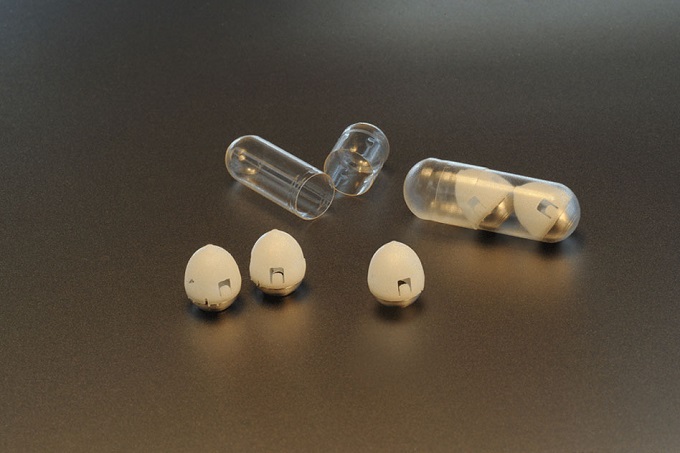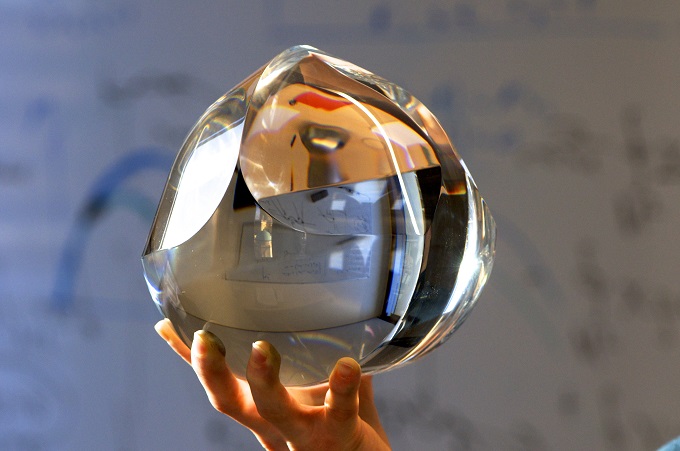2019. March 14.
The results of BME’s researchers played a key role in the development of a modern insulin applicator for diabetic patients.
“While the Gomboc is a homogeneous body with very gentle geometry, this shape has a wide variety of applications if you want to design an inhomogeneous apparatus (i.e. one equipped with a ballast) which is easily reoriented by gravity, such as a roly-poly toy. This observation led to a number of surprising technical applications including the insulin capsule as probably the most intriguing example published recently in Science Magazine,” replied Gábor Domokos, academic, professor at the Department of Mechanics, Materials and Structures at BME’s Faculty of Architecture (ÉPK) and head of the MTA-BME Morphodynamics Research Group to bme.hu’s question.
Péter Várkonyi and Gábor Domokos, the inventors of Gomboc
This innovation, which has been already successfully tested in animals, was developed by the researchers of the prestigious Massachusetts Institute of Technology (MIT) and Harvard University primarily for patients with type 2 diabetes who are required to give themselves the hormone produced by the pancreas by injection or infusion every day. The device, which replaces the sometimes painful injections, is a small capsule containing a needle made of compressed insulin attached to a compressed spring held in place by a disk made of sugar. When the capsule is swallowed, water in the stomach dissolves the sugar disk, releasing the spring and injecting the needle. One of the unavoidable disadvantages of oral drug administration with diabetic patients is that the stomach acid breaks down the active agents but this new system injects the drug directly into the stomach wall allowing the insulin to be immediately released into the bloodstream.

Photo source: Felice Frankel/MIT
One of the key criteria of the operation of the small device developed by the experts of MIT and Harvard for the needle injecting the stomach wall to be in the right position so they designed a peculiar shape. Their study references the Gomboc, the first known homogeneous mono-monostatic body as the inspiration for the capsule (which is mono-monostatic, i.e. has a single stable and a single unstable point of balance). By relying on the study published by BME’s researchers, the authors of the American publication demonstrate their idea through the example of the shell of the leopard tortoise: the evolution of this reptile led to a favourable geometry allowing the tortoise to right itself if it rolls onto its back. The publication describing the capsule references two studies written by Gábor Domokos and Péter Várkonyi, associate professor of ÉPK’s Department of Mechanics, Materials and Structures, one of them discussing the Gomboc and the other its relation to tortoise shells.

Photo: Alain Goriely/EPSRC
|
The Gomboc is the first known homogeneous object with one stable and one unstable equilibrium point, thus altogether two equilibria. This object first invented by Gábor Domokos and Péter Várkonyi is a constructive solution to the theoretical problem introduced by the Russian mathematician, Vladimir Arnold. The idea of the Gomboc led to the development of the mathematical models that help describe the process of natural abrasion. These models (in line with measurements) predict the reduction of the static equilibria in the abrasive process (suggesting that all bodies advance to reach the shape of the Gomboc) but most of these bodies stop at some point in this process resulting in bodies with very few but more than two equilibria, i.e. “imperfect Gomboc”. As Sir Michael Berry, British mathematical physicist once put it: “Gomboc exists in nature but only as a dream” meaning that it explains many processes but it never materialises in nature. |
“We rarely see that a mere theory formed originally on a writing desk evolves into a mechanical idea so quickly and in such a tangible way leading eventually to the development of a useful medical innovation,” stressed Gábor Domokos adding that the concepts triggered by the discovery of the Gomboc have been applied productively in many disciplines in recent years. The researcher thinks it is important that this shape is a good starting point to design objects orienting always in the same direction even if they are not fully homogeneous but they orient in the same direction with even a very small difference in weight distribution, which could promote the development of many technical applications. However, the theoretical background related to the Gomboc continues to primarily help scientists understand the shape evolution processes of inanimate nature.
|
The shape evolution of Martian pebbles or the form of the asteroid discovered in 2017 were widely reported in the press around the world recently. In the former study, the Hungarian researchers suggested abrasions that were potentially caused by streams and rivers once flowing on Mars and they also estimated the length and the yield of these bodies of water while the theory developed by the mathematicians in the latter paper may explain how the comet was created and what changes happened on its surface over a period of hundreds of millions of years. The mathematical implications of the shape of the Gomboc do not only help understand distant worlds or the shape evolution of pebbles abraded by earthly seas and oceans. For example, in the drone laboratory of the University of Pennsylvania, one of the leading research labs in the world, swarming drones are placed in a cage modelled after the shape of the Gomboc so that they can bounce back when they collide with other objects. |
“Researchers studying abstract disciplines are frequently asked by laymen: this sounds great but what is it good for?” Gábor Domokos cited the common question and explained that “the conclusions drawn from the shape evolution of Martian pebbles or the universal features of the shape of an asteroid are undoubtedly useful from the aspect of science but the way these benefit from the basic research (i.e. the Gomboc) needs a longer explanation. In contrast, the relevance of the basic research is evident from sensational developments such as the insulin delivery capsule designed by the American experts is obvious as it is enough to take a look at the images of the capsule and the Gomboc side by side.”
The formal framework for the research conducted by the academic and his colleagues is provided by the MTA-BME Morphodynamics Research Group. Gábor Domokos is highly pleased that their results are used by well-known foreign researchers. For example, the lead author of the study on the insulin capsule is Robert S. Langer, the professor of MIT’s David H. Koch Institute, who is one of the most renowned authorities on the application of engineering innovations in medicine and the pharmaceutical industry in the world.
“The Gomboc shows how a purely mathematical problem can be converted into a practical device used in everyday life in even a very short period of time. On the one hand, this motivates theoretical researchers, and on the other hand, demonstrates the interaction between basic and applied research. Both need to be promoted as this allows the planning and continuous practice of scientific research and innovation. BME is strongly committed to using its development capacities: the Gomboc, as a great example of research synergies, demonstrates the process of innovation,” Gábor Domokos explained.
HA-GI
Photo: János Philip


